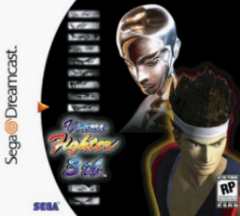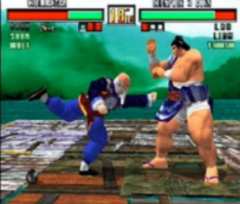 Sega's
Virtua Fighter 3tb (Team Battle) is an excellent fighting game with a deep and
challenging
combat system that will challenge the best players to master
it.
At first, the experience may seem a bit dry, but as you learn the
nuance
and subtleties included in the game you really get a sense of
enjoyment
and satisfaction from playing and mastering it. While the
less-than-cutting-edge
presentation and a lack of extra modes is
disappointing,
VF3tb's core game more than makes up for this. The
realistic
controls and extensive array of offensive and defensive moves
supersede
its sub-par graphics to create an addictive and thorough
Sega's
Virtua Fighter 3tb (Team Battle) is an excellent fighting game with a deep and
challenging
combat system that will challenge the best players to master
it.
At first, the experience may seem a bit dry, but as you learn the
nuance
and subtleties included in the game you really get a sense of
enjoyment
and satisfaction from playing and mastering it. While the
less-than-cutting-edge
presentation and a lack of extra modes is
disappointing,
VF3tb's core game more than makes up for this. The
realistic
controls and extensive array of offensive and defensive moves
supersede
its sub-par graphics to create an addictive and thorough
The
series has evolved significantly from previous installments. Several
new
features have been added including a new escape button that allows
you
to dodge attacks. This adds a new layer onto the already intricate
fighting
system, and also makes this the first Virtua Fighter game to
effectively
use 3D space. Another big change is
that jumping is more
realistic
in two ways. First, you have to press the joystick down then
up
to perform a jump, and secondly, the fighters don't linger in the air
as
they did in previous game. The new jumping mechanics both maximize
realism
and makes the game more difficult, this is actually a good thing
because
it maximizes the title's replay value. One of the first things
veteran
VF players will notice is that there are now two new selectable
characters
who have been added to the cast along with another two hidden
fighters.
Beyond the core fighting game, there are a few extras in
VF3tb.
The game has a training mode that allows you to practice against
a
dummy opponent and a team mode where you can select three fighters to
fight
against another three. There's also a vs mode where you and a
friend
can exchange blows. The extra modes in the game are the usual but
fairly
mandatory at this point and little beyond what's expected. You
won't
find very many hidden secrets beyond unlocking a secret character
VF3tb's
no-frills fighting style is simultaneously simple and
sophisticated.
The game emphasizes a balance over flash. Challenging
gamers
to fight with both offensive and defensive moves over special
moves
creates a more satisfying, longer-lasting experience. It requires
some
patience and skill, but once you get into the rhythm of the game,
it's
beauty and realism causes it to shine brightly. There are loads of
little
nuances to master and understand making for a game that will keep
fighting
fans very busy for months on end. The controls consist of the
usual
kick, punch and block buttons with the addition of the new escape
button,
there are a mere 4 buttons to use, seems simple right? You can
This
is because, as in all of the VF games so far, the simple interface
is
deceptive and belies the complexity underneath. For example, it's not
immediately
apparent, but the distance between opponents significantly
affects
how effective your moves are, as does the timing of your attack. Another
factor in playing is your skill in dodging attacks. This game
doesn't
really have special moves or flashy combos, but you can pull off
some
fairly elaborate and devastating attacks if you put together the
right
combos and chain moves together. The intricacy and elegance of the
fighting
system is the game's best aspect, as there is a lot of room for
individual
styles to emerge in the game. Additionally, the game's
characters
are extremely well balanced with complementary strengths and
VF3tb's
major innovation seems subtle at first glance but is actually
crucially
important to the game. You may notice are the variable heights
and
shapes of its stages and not think much of it at first - thinking
like
that would be a huge mistake on your part.
The height where you
stand
has a significant impact on your attacks and how much damage they
cause
an opponent. Standing above an opponent makes it easier to inflict
damage
while standing below an adversary leaves you slightly more
vulnerable.
This effects everything to throw effectiveness and where and
when
you want to dodge. Since each stage in the game has a unique
layout,
you need to constantly monitor the rings during each fight to
avoid
the dreaded ring outs. There is a huge defensive component in the
game
that makes this significantly more complex than you expect, making
the
player spend just as much avoiding damage as they do inflicting it.
Getting
knocked down by the opponent can also be used to your advantage
because
you can choose how to get up: in a defensive crouch, roll away
or
attack your opponent as soon as you're back on your feet. This
intricate
fighting system seems incredibly complex, but the controls in
the
game are so highly intuitive, it's only a matter of mastering the
timing
in order to succeed. This
complexity is VF3tb's greatest asset -
and
it's greatest liability. If you have the time and desire to
appreciate
the depth this is great game. Casual gamers and button
mashers
won't find this as satisfying. For the hard-core gamer, Virtua
Fighter
3tb gets more enjoyable as you learn the extensive moves and
become
more proficient at dodging attacks. VF3tb is a deep fighter with
plenty
of moves, mastering it requires patience and persistence. You'll
spend
a lot of time learning an extensive arsenal of dodges, escape
moves
and counters to successfully head off attacks but find this a
satisfying
and rewarding experience. As is usually the case, the
controls
are excellent, showing a high degree of both responsiveness and
intuitiveness.
The standard DC control pad makes a decent gameplay
experience
but, as we reviewers are apt to point out, 'investing' in an
arcade
stick offers vastly superior controls plus makes playing more
 VF3tb's
biggest faults lie in its disappointing visuals - character
models
display a lack of detail and also lack some of the detail shown
in
the arcade game. The character movements aren't as fluid or lifelike
as
you'd expect. In a major misstep, VF3tb is one of the few fighting
games
to attempt implementation of a first person view. This view is
horrible
to use, since it's near impossible to tell where you are in
relation
to your opponent, why this was included is puzzling - it's only
real
use would be in replays. The graphics glitch annoyingly in some key
areas
and the characters themselves display several noticeable rough
edges,
particularly in their leg joints. The game is also missing some
minor
but annoying touches that made the arcade game special.
While not
horrible,
this conversion is somewhat disappointing because it squanders
the
Dreamcast's potential. Soul Calibur proves the hardware could have
and
should have easily handled a perfect (if not beyond perfect) port of
a
three-year old game's graphics, but this conversion chokes.
Though
VF3tb
looks good in places, better than any fighter on N64 or
graphics
Namco implemented in Soul Calibur. It's a bit odd that Sega is
VF3tb's
biggest faults lie in its disappointing visuals - character
models
display a lack of detail and also lack some of the detail shown
in
the arcade game. The character movements aren't as fluid or lifelike
as
you'd expect. In a major misstep, VF3tb is one of the few fighting
games
to attempt implementation of a first person view. This view is
horrible
to use, since it's near impossible to tell where you are in
relation
to your opponent, why this was included is puzzling - it's only
real
use would be in replays. The graphics glitch annoyingly in some key
areas
and the characters themselves display several noticeable rough
edges,
particularly in their leg joints. The game is also missing some
minor
but annoying touches that made the arcade game special.
While not
horrible,
this conversion is somewhat disappointing because it squanders
the
Dreamcast's potential. Soul Calibur proves the hardware could have
and
should have easily handled a perfect (if not beyond perfect) port of
a
three-year old game's graphics, but this conversion chokes.
Though
VF3tb
looks good in places, better than any fighter on N64 or
graphics
Namco implemented in Soul Calibur. It's a bit odd that Sega is
Another
problem area with VF3tb's presentation the sound effects and
music
which is not that good. To start with, the voice-overs are
repetitive
and don't fit the character's lips very well. The punching
and
kicking sound effects are also below par, feeling overly cartoony
and
unrealistic, disrupting the realism the game aspires to. The music
in
the background is decent, if a bit too light for what is an intense
and
cerebral brawler. Despite
all of these problems, VF3tb still stands as an excellent
fighting
game. It's graphics are disappointing, it lacks secrets
characters,
costumes and other gimmicks, plus the voice-overs are
decidedly
unconvincing, but VF3tb's sophisticated and elegant gameplay
is
the game's main appeal. The depth and nuance of play that VF3tb
delivers
makes this a close second in the battle for best Dreamcast
fighter.
Some may not enjoy the complexity of its fighting system, but
mastering
the moves and strategies in the game is incredibly addictive
and
enjoyable. Playing VF3tb successfully will take a lot of time and
effort
to accomplish any level of proficiency but the game is so

